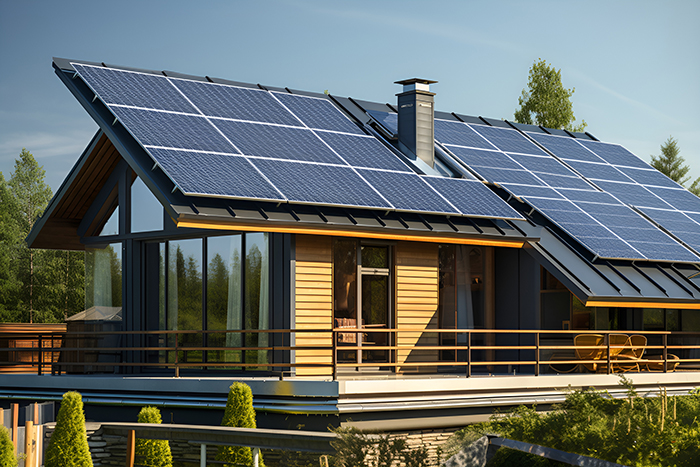Amid the wave of energy transition and sustainable development, distributed photovoltaics (PV) are rapidly reshaping global energy landscapes as a crucial component of clean energy. With continuous technological innovation, sustained policy support, and growing market demand, the distributed PV sector is witnessing new and significant trends.

1. High-Power Modules on Rooftops
Under the integration of high-efficiency technologies, the power of PV modules is rapidly increasing, with 600W+ and 700W+ products becoming the main offerings of module companies. High-power modules are not just favored by ground-mounted power stations but are also quickly being adopted for rooftop installations. At industry exhibitions, leading module manufacturers have explicitly promoted the concept of "700W+ modules on rooftops."
According to these manufacturers, distributed PV, especially residential installations, particularly favor high-power modules due to the prevalent rental model where roof space is rented per module. For developers, high-power modules not only reduce rental costs but also lower the balance of system (BOS) costs, thereby strongly promoting their adoption.
2. Significant Advancements in N-TOPCon Modules
The rapid iteration between P-type and N-TOPCon technologies is equally evident in the distributed PV market. According to InfoLink statistics, the market shares of P-type and N-TOPCon modules were approximately 71% and 27%, respectively, in 2023. However, N-TOPCon modules are expected to quickly rise to 79% this year.

In the distributed market, feedback from module manufacturers indicates that N-TOPCon products might account for more than 60% of the distributed PV market this year, with the pace of iteration far exceeding expectations.
3. Diverse Market Demands Gain Attention
The diversity of distributed PV scenarios dictates varying product requirements, driving manufacturers to innovate continually. For instance, addressing the dust accumulation issue in distributed PV plants, companies like LONGi, Jinko, and Trina have introduced anti-dust modules. For humid and hot environments, LONGi has launched new moisture-resistant products.
Additionally, lightweight flexible modules are gaining attention, with leading companies including Nanjing Daily Photovoltaic, SunMan, and Pinsine Solar. According to these companies, the primary markets for lightweight flexible modules include roofs with load restrictions and curved buildings. Currently, these modules can reach up to 500W+ in power but are priced about twice as much as conventional modules.
4. Quality Concerns Amid Price Wars
Since the second half of last year, due to capacity clearing and market competition, PV module prices have plummeted, with the price of P-type modules falling below 0.8 RMB per watt by the end of last year. At the recent Shandong PV exhibition, some companies boldly advertised "0.7+ RMB/W modules." However, exhibition attendees revealed that some products did not achieve the advertised maximum power. Although prices can drop to 0.6 RMB/W or even lower, the compliance and quality of these products are questionable.
Hence, it is crucial for distributed PV investors and owners to strictly select reputable brands and rigorously check module quality to avoid unnecessary losses.
5. Higher Power Commercial and Industrial Inverters
To further reduce system costs, commercial and industrial inverters are moving from mainstream 110kW and 125kW to higher power levels, such as 150kW. Companies like Sungrow, TBEA, Hiconics, and Growatt showcased 150kW commercial string inverters. To accommodate high-power modules, the input current of inverters continues to increase, with some leading companies' 110kW string inverters reaching a maximum input current of 64 amps.
6. Rush for Grid Connection
Feedback from both equipment manufacturers and developers indicates that one major driving force behind the rapid recovery of the distributed PV business is the urgency of grid connections.
Since the second half of last year, several provinces, including Hebei, Shandong, Heilongjiang, Henan, Zhejiang, Guangdong, and Fujian, have issued warnings about the carrying capacity of distributed PV grid connections. In many areas, new capacity is no longer available. Consequently, grid connection has become a new benchmark for distributed PV competition, with grid carrying capacity becoming a critical factor limiting new installations.
7. Intense Platform Competition
On one hand, there is a pressing shortage of grid absorption capacity; on the other hand, there is a surge of development companies. At the Shandong exhibition alone, there were over 30 distributed PV platform companies, ranging from traditional PV developers like Chint Aneng, Trina Solar's residential arm, and JA Solar's smart energy division to home appliance companies like Skyworth PV, Haier Solar, TCL PV Technology, and Midea. Local platform companies are also expanding their businesses outward.
In terms of business models and solutions, there are numerous options, including full payment for residential installations, cooperative construction, operational leasing, pure leasing, commercial energy management contracts (EMC), owner investments, zero-carbon benefits, and full-feed-in tariffs. Solutions cover flat roofs, sloped roofs, flat-to-slope roof conversions, sunshades, and building-integrated photovoltaics (BIPV). The competition among platforms is fierce, varying from processes to services.
8. Rising Channel Fees
The intense competition between platforms and the widely dispersed rooftop resources dictate a heavy reliance on channel partners and increasing channel fees. Reportedly, in the residential PV market in Shandong, intermediary fees for a single PV panel soared to 300-400 RMB last year, doubling from previous levels.
For commercial and industrial rooftop intermediary services, some companies at the Shandong exhibition clearly advertised fees of "0.05-0.3 RMB/W."
9. Concentrated Confluence Mode Gains Attention
Given the constraints on distributed PV installation potential due to limited grid connection capacity, both the government and developers are exploring breakthrough paths. As a result, the concentrated confluence mode is becoming a key promotional focus for companies, with several platform companies showcasing the slogan "Install without space limitations."
Concentrated confluence refers to connecting multiple residential rooftop PV plants through a confluence route, using boosting equipment to centralize voltage boosting for grid connection. This method follows non-natural person grid connection requirements and construction management schemes. It is suitable for low-voltage distribution networks with no additional capacity, where the power supply station supports transformer investment, and the upper-level substation has sufficient capacity, as well as for village-wide rooftop development in relatively concentrated areas.
10. Distribution Transformer Storage Enters the Market
Besides concentrated confluence, another path to achieve transformer capacity expansion is distribution transformer storage, typically installed at power distribution substations or within transformer districts. The excess power generated by distributed PV can be directly stored in energy storage systems without passing through transformers, thus solving the problem of transformer capacity limitations. It can also address instantaneous load fluctuations and peak load demands in the distribution network, enhancing grid stability.
According to industry estimates, with a storage ratio of 15%, a 200kW/400kWh energy storage system can increase distributed PV development capacity by approximately 1.2MW, with the storage system cost adding about 0.4-0.5 RMB/W.
In conclusion, 2024 marks another pivotal year for distributed PV. The healthy and sustainable development of the industry relies on policy regulations from all levels of government and the innovative solutions and business models from countless industry players, benefiting all stakeholders and supporting zero-carbon initiatives.







